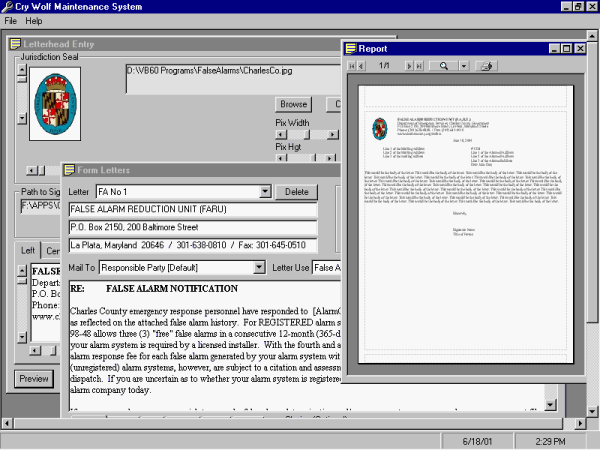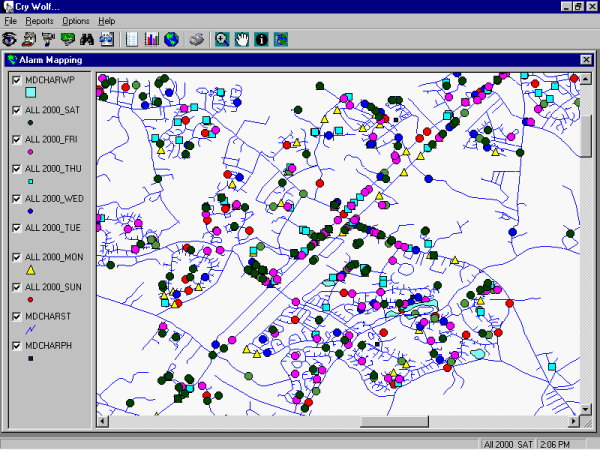
Linking GIS capabilities with an automated software system such as CryWolf™ for the tracking and processing of false alarm calls has resulted in a more efficient use of time and resources and a reduction in false alarms. Charles County, Maryland’s False Alarm Reduction Office in collaboration with PSC has served as the initial site for the operation and evaluation of the CryWolf™ software. Alarm data is imported from the Computer Aided Dispatch and used to send letters and prepare reports. Data and statistics can alsobe graphically presented on local county maps using Map Objects programming. Additionally, graphs and charts can be prepared and exported to other programs for use in reports to management.


The number of municipalities adopting alarm legislation is rapidly increasing due to the growing concern over police officer safety and the costs related to the reduction in manpower and resources due to false alarms. Unfounded alarm calls reduce law enforcement effectiveness and undermine their ability to respond to more critical calls. For residential and business property owners who are concerned about crime, alarm systems offer an added sense of safety and security. They can be an effective crime deterrent, but if they are unreliable and result in false alarms, they pose a major problem for everyone.
Due to the requirements for new legislation and the resulting delays in trying to create a quick fix in-house, there is a growing need for a sophisticated software system to assist in the tracking and processing of alarms. Public Safety Corporation (PSC) has created a GIS-based application that brings the power of geo-spatial analysis to the false alarm arena. Utilizing Esri’s MapObjects v2.0 allows CryWolf™ to be translated into a comprehensive program planned, designed, and created specifically to track false alarms.
Unlike current software solutions, CryWolf™ is a very user-friendly system that maps alarm locations, allowing for the visual interpretation of alarm patterns. Agencies can customize multiple program features such as clearance codes, letter formatting, and custom letterhead design and utilize a variety of Data Collection Modules for Alarm Companies, Alarm Registrations and Alarm Call Entry. CryWolf™ is designed to use enhanced TIGER data 'shape' files for the current jurisdiction, and offers the mapping capabilities that geo-spatial users expect. Truly customized software for tracking false alarms can cost up to several hundred thousands dollars. The more elaborate the requirements are and the more customization requested by the user, the more costly the software will become. CryWolf™ is designed as a generic false alarm application with a variety of customization features. This allows the software to accommodate the needs of many jurisdictions without having to resort to custom code.

Most customizations can be accomplished via the 'Table Maintenance' screen. All system tables can be customized for the location used. Users can control access via personal logons. Letterhead can be customized in two different ways. All letters are designed to work with windowed envelopes to reduce costs, and yet the program is designed to create mailing labels for those who wish to use them. The use of customization screens in a more generic program reduces the overall costs of creating and maintaining the system, and yet offers the user a very sophisticated and powerful approach to track false alarms.

Public Safety Corporation (PSC) recently installed a false alarm and tracking management application called CryWolf™ for the Charles County, Maryland (111,050) False Alarm Reduction Unit (FARU). Linking GIS capabilities with an automated software system such as CryWolf™ for the tracking and processing of false alarm calls has resulted in a more efficient use of time and resources and a reduction in false alarms. During the initial testing and verification phase, almost 7000 false alarm calls have been processed through the program. Test notifications, and invoices have been mailed to hundreds of County residents to date. The receipt of these letters has already impacted the County by accelerating the number of registrations being received each day. Donald P. McGuire, Director of FARU remarked that
"with the CryWolf™ application we’ve been able to accomplish more in the past 4 months than what we were able to do in the preceding 16 months!"
CryWolf™ operates by importing alarm data from the Computer Aided Dispatch, which is used to send letters and prepare reports. Data and statistics can also be graphically presented on local county maps using Map Objects programming. The ability to map alarm locations allows for the visual interpretation of alarm patterns. Additionally, graphs and charts can be prepared and exported to other programs for use in reports to management. Denise Shaw, FARU Administrator, sees CryWolf™ as both a functional and planning tool;
"I can show the alarm counts by a whole host of criteria and show it in charts, graphs and even on maps. I envision using this to provide visuals to our County Commissioners and perhaps to alarm companies and users during presentations and training sessions to illustrate the impact and severity of the problem."
Charles County experiences approximately 40 false alarms each day. The various automated processes included in the CryWolf program allow for each day of false alarm calls to be completely processed in less than 30 minutes. The generation of printed letters is accomplished with the click of a button. The appearance of the correspondence to constituents is very important to a local government. The CryWolf program allows the County to create totally customized letterhead, and even allows them to include the County seal in each letter. False Alarm personnel have already entered over 3,000 registrations and are expecting in excess of 9,000 by the time all registrations are received. The ease of using the CryWolf program has greatly reduced the time required to process each registration form.
According to the Mr. McGuire, the implementation of the CryWolf™ application
"has made the FARU more efficient and effective in reducing false alarms and he looks forward to its continued contribution to reducing the false alarm rate in Charles County."
The reduction in false alarms is essential to address the rising costs to taxpayers, raise additional funds to be allocated towards community education and crime prevention, increase response time and presence in the community and free up personnel from manual tasks by providing the billing mechanism to generate fees, which will more than pay for the initial investment in the CryWolf™ application. Furthermore, alarm users will gain a better understanding of the impact of repeated false alarms, with more alarm businesses and owners inspecting and updating their systems to prevent further false alarms.
Bill Schroeder
Director
AOT Public Safety Corporation
48015 Pine Hill Run Road
Building 2, Suite 17
Lexington Park, MD 20653
Phone: 301 863-0422
Fax: 301 866-0889
E-mail: bschroeder@aot.com
Jamie Thorness
Program Manager
AOT Public Safety Corporation
48015 Pine Hill Run Road
Building 2, Suite 17
Lexington Park, MD 20653
Phone: 301 866-0887
Fax: 301 866-0889
E-mail: jthorness@aot.com
Denise Shaw
Director, False Alarm Unit
Charles County Government
200 Baltimore Street
La Plata County, MD 20646
Phone: 301 638-0810